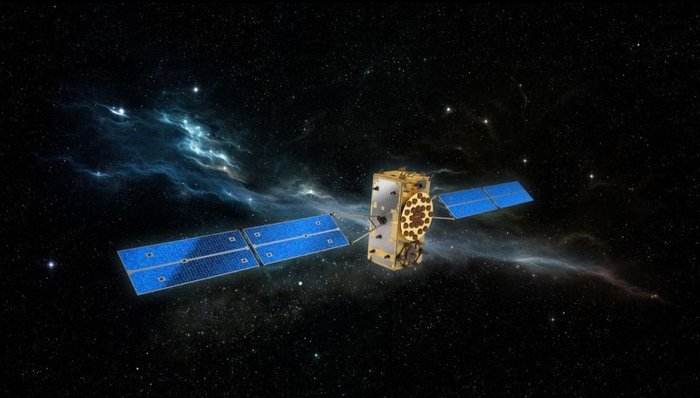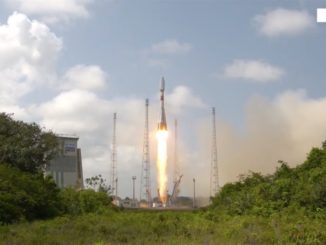
Two more satellites joined Europe’s Galileo navigation fleet in orbit Thursday after launch from French Guiana aboard a Soyuz rocket, giving the system a dozen of its planned 30 members as the European Commission begins ordering eight more satellites to complete construction of the multibillion-dollar network.
The two satellites, the 11th and 12th spacecraft in the Galileo constellation, blasted off at 1151:56 GMT (6:51:56 a.m. EST) from the Guiana Space Center in South America.
The Soyuz rocket steered on a track northeast from the jungle spaceport, leaving four strap-on boosters twisting in its wake two minutes after liftoff, then shedding a nose cone to reveal the twin Galileo spacecraft a few minutes later.
A Fregat upper stage took over about 10 minutes into the mission, conducting two engine firings separated by a three-hour coast as it arced to the Galileo satellites’ target altitude about 23,500 kilometers (14,600 miles) above Earth.
The second burn circularized the orbit, then the Fregat released dual navigation payloads at 1539 GMT (10:39 a.m. EST).
Officials declared the launch a success after confirming the health of the satellites and verifying the rocket put the payloads in the correct orbit.
The high-altitude satellite deployment concluded the third Soyuz launch for the Galileo navigation program this year, doubling the number of satellites in the fleet in the process. It was the 13th Soyuz launch from French Guiana under the commercial auspices of Arianespace since the rocket’s debut there in 2011.
“Three (launchers) and six satellites ready for launch in less than nine months,” said Didier Faivre, the European Space Agency’s director of navigation, in a conference call with reporters before Thursday’s launch. “This shows that the pace of production, of testing and launching is now there, and this increases the confidence that we can achieve the full deployment.”
The satellites launched Thursday were made by OHB of Bremen, Germany, with navigation instrumentation built by Britain’s Surrey Satellite Technology Ltd.
The launch targeted Plane C of the Galileo system, which spreads its satellites among three orbital planes to create uniform worldwide navigation availability. Specifically, the satellites will go into Slots C2 and C7, according to Javier Benedicto, Galileo project manager at the European Space Agency.

ESA manages the procurement and technical details of the Galileo system for the European Commission, the executive body of the EU, which owns the network.
The satellites, which each weigh about 717 kilograms (1,580 pounds), will use on-board thrusters to position themselves in the Galileo constellation about 300 kilometers (186 miles) below the altitude targeted by Thursday’s launch.
Engineers intentionally inject the Galileo satellites into a “graveyard orbit” above the operational navigation fleet to avoid clogging the constellation’s orbit with space junk in case of a problem.
Faivre said the launch into Plane C of the Galileo constellation will give each of the three orbital planes four satellites, evenly distributing the satellites around the world.
But three of the 10 satellites launched before Thursday have technical glitches that may prevent their ability to offer all the navigation services advertised by the European Commission.
Two Galileo satellites launched into the wrong orbit by a Soyuz/Fregat in August 2014 are healthy, but they did not carry enough propellant to fully recover from the orbit shortfall. The spacecraft are circling Earth in an elliptical orbit, not the circular path required for full service.
“Since then, the European Space Agency has done a marvelous job to recover the satellites and place them in a better orbit,” said Paul Flament, head of the satellite navigation unit at the European Commission. “Unfortunately, that better orbit is not the ideal one, which we thought we should have reached right from the beginning.”
Flament said ground controllers are putting the two satellites through tests to see how they can be incorporated into the Galileo system despite the bad orbit.
“Most probably, we will be able to use those two satellites for search-and-rescue functions,” Flament told reporters Wednesday. “This is almost 100 percent sure, and most probably we will be able to make use of those two satellites also for the open service.”
The European Commission has set up several layers of navigation services, including one product freely available to anyone in the world — called the open service — and commercial-grade and restricted services for businesses and government users.
Flament said the two satellites from the August 2014 launch will probably not join the regulated security navigation service, which is tailored for military and government users.
Another Galileo spacecraft launched as a validation satellite in 2012 has a problem with its L-band navigation antenna, and it is not clear whether it will ever fully join the operational fleet, Benedicto said.
Nevertheless, with the satellites launched Thursday, the Galileo constellation should have at least nine fully available members by the first half of 2016, Faivre said.
Four more satellites are slated for launch on an Ariane 5 ES rocket in October, marking the heavy-duty launcher’s first flight in support of the Galileo program. The Ariane 5 launch next year, using a restartable Aestus upper stage engine, will put the Galileo more than halfway to deploying the full constellation, which will consist of 24 active satellites and six in-orbit spares.
A new dispenser to haul four satellites on the Ariane 5 rocket will be qualified for flight in early 2016.
Two Galileo satellites are due to launch on another Soyuz rocket in late 2016 or early 2017, followed by two more Ariane 5 flights in 2017 and 2018 to round out the first batch of 26 satellites currently under contract.
Flament said the European Commission plans to release this week an invitation for industry to submit proposals to build eight more Galileo satellites similar to the spacecraft already launching.
“We know that we are lacking four satellites to complete the constellation of 30 satellites,” Flament said. “This is the reason why we are launching an invitation to tender to procure new satellites to complete the constellation. That invitation to tender, that procurement is starting now.”
Flament said the eight spacecraft, four of which are needed to meet Europe’s goal of launching 30 Galileo satellites by 2020, will carry the same technology as the existing payloads.
“It’s not that we are going to invent new services or impose new technologies,” Flament said. “They are in the same vein of those of what you would call the first generation.”
Email the author.
Follow Stephen Clark on Twitter: @StephenClark1.



